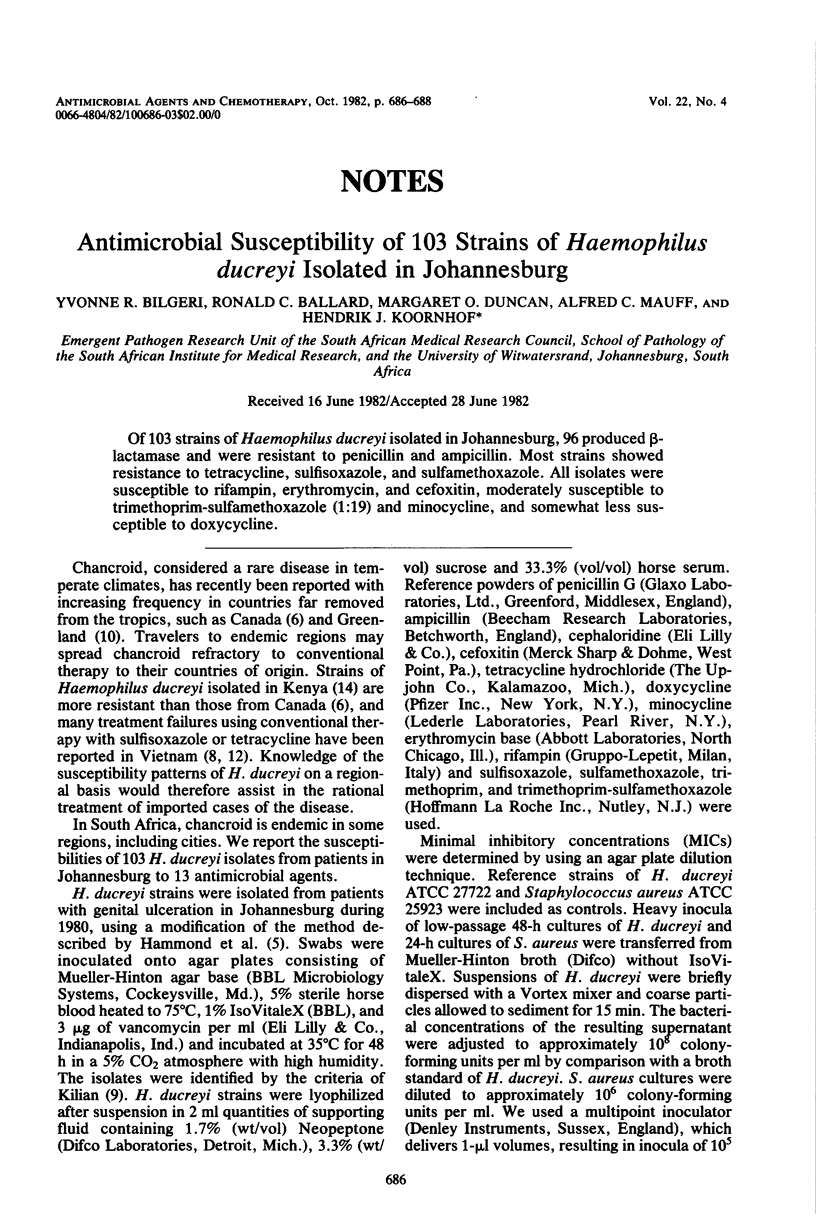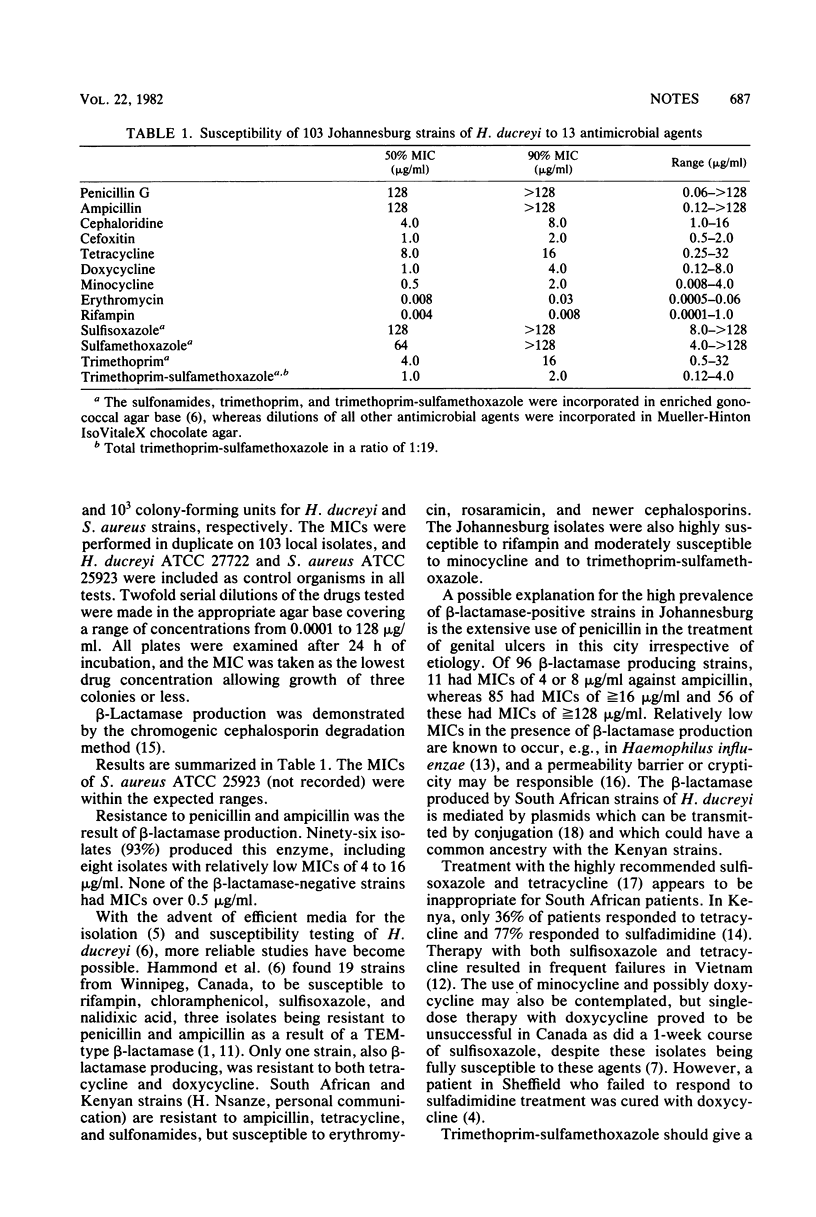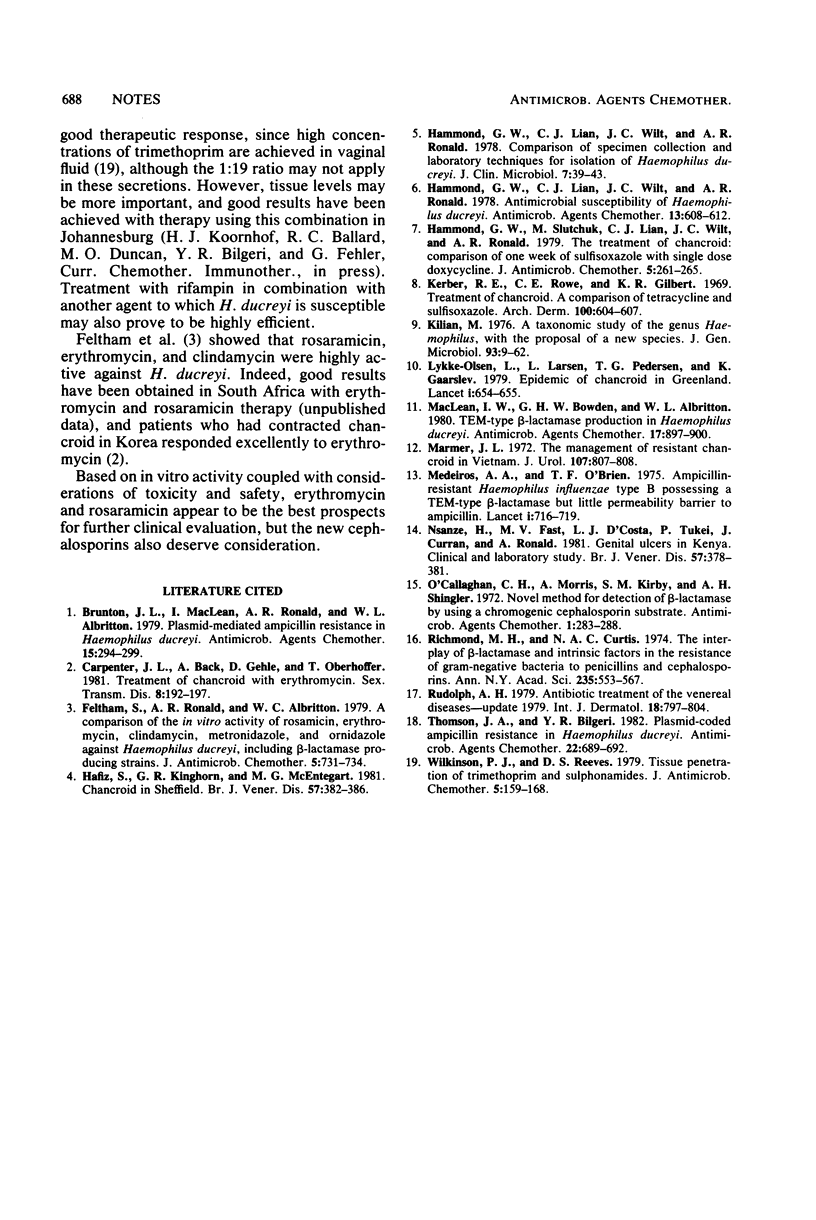Abstract
Of 103 strains of Haemophilus ducreyi isolated in Johannesburg, 96 produced beta-lactamase and were resistant to penicillin and ampicillin. Most strains showed resistance to tetracycline, sulfisoxazole, and sulfamethoxazole. All isolates were susceptible to rifampin, erythromycin, and cefoxitin, moderately susceptible to trimethoprim-sulfamethoxazole (1:19) and minocycline, and somewhat less susceptible to doxycycline.
Full text
PDF


Selected References
These references are in PubMed. This may not be the complete list of references from this article.
- Brunton J. L., Maclean I., Ronald A. R., Albritton W. L. Plasmid-mediated ampicillin resistance in Haemophilus ducreyi. Antimicrob Agents Chemother. 1979 Feb;15(2):294–299. doi: 10.1128/aac.15.2.294. [DOI] [PMC free article] [PubMed] [Google Scholar]
- Carpenter J. L., Back A., Gehle D., Oberhoffer T. Treatment of chancroid with erythromycin. Sex Transm Dis. 1981 Jul-Sep;8(3):192–197. doi: 10.1097/00007435-198107000-00004. [DOI] [PubMed] [Google Scholar]
- Feltham S., Ronald A. R., Albritton W. L. A comparison of the in vitro activity of rosamicin, erythromycin, clindamycin, metroidazole and ornidazole against Haemophilus ducreyi, including beta-lactamase producing strains. J Antimicrob Chemother. 1979 Nov;5(6):731–734. doi: 10.1093/jac/5.6.731. [DOI] [PubMed] [Google Scholar]
- Hafiz S., Kinghorn G. R., McEntegart M. G. Chancroid in Sheffield. A report of 22 cases diagnosed by isolating Haemophilus ducreyi in a modified medium. Br J Vener Dis. 1981 Dec;57(6):382–386. doi: 10.1136/sti.57.6.382. [DOI] [PMC free article] [PubMed] [Google Scholar]
- Hammond G. W., Lian C. J., Wilt J. C., Ronald A. R. Antimicrobial susceptibility of Haemophilus ducreyi. Antimicrob Agents Chemother. 1978 Apr;13(4):608–612. doi: 10.1128/aac.13.4.608. [DOI] [PMC free article] [PubMed] [Google Scholar]
- Hammond G. W., Lian C. J., Wilt J. C., Ronald A. R. Comparison of specimen collection and laboratory techniques for isolation of Haemophilus ducreyi. J Clin Microbiol. 1978 Jan;7(1):39–43. doi: 10.1128/jcm.7.1.39-43.1978. [DOI] [PMC free article] [PubMed] [Google Scholar]
- Hammond G. W., Slutchuk M., Lian C. J., Wilt J. C., Ronald A. R. The treatment of chancroid: comparison of one week of sulfisoxazole with single dose doxycycline. J Antimicrob Chemother. 1979 May;5(3):261–265. doi: 10.1093/jac/5.3.261. [DOI] [PubMed] [Google Scholar]
- Kerber R. E., Rowe C. E., Gilbert K. R. Treatment of chancroid. A comparison of tetracycline and sulfisoxazole. Arch Dermatol. 1969 Nov;100(5):604–607. [PubMed] [Google Scholar]
- Kilian M. A taxonomic study of the genus Haemophilus, with the proposal of a new species. J Gen Microbiol. 1976 Mar;93(1):9–62. doi: 10.1099/00221287-93-1-9. [DOI] [PubMed] [Google Scholar]
- Lykke-Olesen L., Larsen L., Pedersen T. G., Gaarslev K. Epidemic of chancroid in Greenland 1977-78. Lancet. 1979 Mar 24;1(8117):654–655. doi: 10.1016/s0140-6736(79)91091-2. [DOI] [PubMed] [Google Scholar]
- MacLean I. W., Bowden G. H., Albritton W. L. TEM-type beta-lactamase production in Haemophilus ducreyi. Antimicrob Agents Chemother. 1980 May;17(5):897–900. doi: 10.1128/aac.17.5.897. [DOI] [PMC free article] [PubMed] [Google Scholar]
- Marmar J. L. The management of resistant chancroid in Vietnam. J Urol. 1972 May;107(5):807–808. doi: 10.1016/s0022-5347(17)61144-3. [DOI] [PubMed] [Google Scholar]
- Medeiros A. A., O'Brien T. F. Ampicillin-resistant Haemophilus influenzae type B possessing a TEM-type beta-lactamase but little permeability barrier to ampicillin. Lancet. 1975 Mar 29;1(7909):716–719. doi: 10.1016/s0140-6736(75)91630-x. [DOI] [PubMed] [Google Scholar]
- Nsanze H., Fast M. V., D'Costa L. J., Tukei P., Curran J., Ronald A. Genital ulcers in Kenya. Clinical and laboratory study. Br J Vener Dis. 1981 Dec;57(6):378–381. doi: 10.1136/sti.57.6.378. [DOI] [PMC free article] [PubMed] [Google Scholar]
- O'Callaghan C. H., Morris A., Kirby S. M., Shingler A. H. Novel method for detection of beta-lactamases by using a chromogenic cephalosporin substrate. Antimicrob Agents Chemother. 1972 Apr;1(4):283–288. doi: 10.1128/aac.1.4.283. [DOI] [PMC free article] [PubMed] [Google Scholar]
- Richmond M. H., Curtis N. A. The interplay of beta-lactamases and intrinsic factors in the resistance of gram-negative bacteria to penicillins and cephalosporins. Ann N Y Acad Sci. 1974 May 10;235(0):553–568. doi: 10.1111/j.1749-6632.1974.tb43290.x. [DOI] [PubMed] [Google Scholar]
- Rudolph A. H. Antibiotic treatment of the venereal diseases--update 1979. Int J Dermatol. 1979 Dec;18(10):797–804. doi: 10.1111/j.1365-4362.1979.tb04466.x. [DOI] [PubMed] [Google Scholar]
- Thomson J. A., Bilgeri Y. R. Plasmid-coded ampicillin resistance in Haemophilus ducreyi. Antimicrob Agents Chemother. 1982 Oct;22(4):689–692. doi: 10.1128/aac.22.4.689. [DOI] [PMC free article] [PubMed] [Google Scholar]
- Wilkinson P. J., Reeves D. S. Tissue penetration of trimethoprim and sulphonamides. J Antimicrob Chemother. 1979 Nov;5(B):159–168. doi: 10.1093/jac/5.supplement_b.159. [DOI] [PubMed] [Google Scholar]


